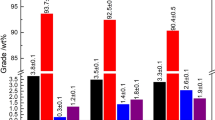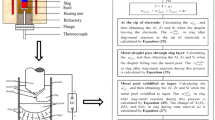Abstract
How to reduce the energy consumption of the rotary kiln-electric furnace (RKEF) process has become an important issue for the stainless steel industry. The aim of this study is to reduce the energy consumption of ferronickel production from saprolite nickel laterite in the RKEF process. The effects of the slag binary basicity, FeO content, and Cr2O3 content on the melting temperature and electric conductivity of the slag as well as the effects of coal dosage, smelting temperature, smelting time, and binary basicity on the smelting process, within the new slag system of CaO–MgO–SiO2–Al2O3–FeO–Cr2O3, have been systematically investigated. It was found that properly increasing the binary basicity and FeO content of slag tends to lower smelting temperature and higher electrical conductivity, while decreasing the Cr2O3 content is beneficial to decreasing the melting temperature of slags as well as the electrical conductivity. Through the optimization of slag composition and smelting parameters, ferronickel with 22.11% Ni, 77.24% Fe, and 0.08% Cr can be obtained at corresponding recovery rates of 99.17%, 28.01%, and 0.54%, respectively, under the conditions of 0.2 binary basicity, coal dosage of 14% at 1550 °C for 30 min based on the guidance of 9.4% CaO-18.2% MgO-47% SiO2-3.4% Al2O3-20% FeO-2.0% Cr2O3 slag system. In addition, the main phase composition of slags obtained is mainly composed of forsterite, hortonolite, enstatite, diopside, and melilite, which have a lower melting point than contrast the slag from industrial production site with the main phase of pyroxene and magnesioferrite olivine. So, the new slag system is helpful for reducing the temperature and time of smelting, and reducing the energy consumption of the RKEF process.
Graphical Abstract










Similar content being viewed by others
References
China Iron and Steel Association (2023) Global stainless steel production in 2022 fell 5.2 percent year-on-year to 55.255 million tons. https://www.chinaisa.org.cn/gxportal/xfgl/portal/content.html?articleId=20ec55c462788321fa9af97817615ea56ae9920c0f28c724350c837e86be13ec&columnId=1bad7c56af746a666e4a4e56e54a9508d344d7bc1498360580613590c16b6c41. Accessed 7 Apr 2023
Wang X, Pan J, Zhu D-Q et al (2020) Process of pelletization of nickel laterite and chromite. Iron Steel 55(3):23–28. https://doi.org/10.13228/j.boyuan.issn0449-749x.20190486. (in Chinese)
Xue Y-X, Zhu D-Q, Pan J et al (2022) Improving sintering performance of limonitic nickel laterite and reducing carbon emissions via the pellet-sintering process. JOM 74:1807–1817. https://doi.org/10.1007/s11837-022-05176-5
Zhu D-Q, Pan L-T, Guo Z-Q et al (2019) Utilization of limonitic nickel laterite to produce ferronickel concentrate by the selective reduction-magnetic separation process. Adv Powder Technol 30(2):451–460. https://doi.org/10.1016/j.apt.2018.11.024
Zhang F, Zhu D-Q, Pan J et al (2019) Effect of basicity on the structure characteristics of chromium-nickel bearing iron ore pellets. Powder Technol 342:409–417. https://doi.org/10.1016/j.powtec.2018.09.100
Tian H-Y, Pan J, Zhu D-Q et al (2020) Improved beneficiation of nickel and iron from a low-grade saprolite laterite by addition of limonitic laterite ore and CaCO3. J Mater Res Technol 9(2):2578–2589. https://doi.org/10.1016/j.jmrt.2019.12.088
Haldar S-K (2017) Platinum–nickel–chromium deposits. Elsevier, Amsterdam. https://doi.org/10.1016/B978-0-12-802041-8.00006-7
Crundwell F-K, Moats M-S, Ramachandran V et al (2011) Extractive metallurgy of nickel, cobalt and platinum group metals, chapter 1-overview. Elsevier, Amsterdam. https://doi.org/10.1016/B978-0-08-096809-4.10001-2
Zhu D-Q, Zhou X-L, Luo Y-H et al (2017) Reduction smelting low ferronickel from pre-concentrated nickel-iron ore of nickel laterite. High Temp Mater Process 35(10):1031–1036. https://doi.org/10.1515/htmp-2015-0025
Wang X, Zhu D-Q, Guo Z-Q et al (2023) Efficient utilization of limonite nickel laterite to prepare ferronickel by the selective reduction smelting process. Sustainability 15(9):7147. https://doi.org/10.3390/su15097147
Zhu D-Q, Cui Y, Hapugoda S et al (2012) Mineralogy and crystal chemistry of a low grade nickel laterite ore. Trans Nonferrous Metals Soc China 22(4):907–916. https://doi.org/10.1016/S1003-6326(11)61264-8
Tian H-Y, Guo Z-Q, Zhan R-N et al (2021) Effective and economical treatment of low-grade nickel laterite by a duplex process of direct reduction-magnetic separation & rotary kiln-electric furnace and its industrial application. Powder Technol 394:120–132. https://doi.org/10.1016/j.powtec.2021.08.043
Quintero-Coronel D-A, Guillin-Estrada W-D, Echeverri-Roman J-L et al (2022) Large- and Particle-Scale energy assessment of reduction roasting of nickel laterite ore for Ferronickel production via the rotary Kiln-Electric furnace process. Thermal Sci Eng Prog 32:101331. https://doi.org/10.1016/j.tsep.2022.101331
Dong-lai MA, Jian-bo MA, Qing-qing HU et al (2022) Effect of additives on growth of ferronickel grains and metal–slag separation behavior. Trans Nonferrous Metals Soc China 32(10):3459–3468. https://doi.org/10.1016/S1003-6326(22)66032-1
Muhammad-Haziq-Uddin L-T-K (2020) The effect of sulfur in rotary kiln fuels on nickel laterite calcination. Miner Eng 157:106563. https://doi.org/10.1016/j.mineng.2020.106563
Liu P, Li B-K, Cheung S-CP et al (2016) Material and energy flows in rotary kiln-electric furnace smelting of ferronickel alloy with energy saving [J]. Appl Thermal Eng 109:542–559. https://doi.org/10.1016/j.applthermaleng.2016.08.095
Norgate T, Jahanshahi S (2011) Assessing the energy and greenhouse gas footprints of nickel laterite processing. Miner Eng 24(7):698–707. https://doi.org/10.1016/j.mineng.2010.10.002
Keskinkilic E (2019) Nickel laterite smelting processes and some examples of recent possible modifications to the conventional route. Metals 9(9):974. https://doi.org/10.3390/met9090974
Rong W, Li B, Liu P et al (2017) Exergy assessment of a rotary kiln-electric furnace smelting of ferronickel alloy. Energy 138:942–953. https://doi.org/10.1016/j.energy.2017.07.119
Wei W-J, Samuelsson P-B, Tilliander A et al (2020) Energy consumption and greenhouse gas emissions of nickel products. Energies 13(21):5664. https://doi.org/10.3390/en13215664
Lin C-F, Zhang W, Fan H-H et al (2022) A kind of RKEF multi-line flue gas waste heat utilization device: China, CN215893277U (in Chinese)
Romero J-M, Pardo Y-S, Parra M et al (2022) Improving the rotary kiln-electric furnace process for ferronickel production: data analytics-based assessment of dust insufflation into the rotary kiln flame. Alexandria Eng J 61(4):3215–3228. https://doi.org/10.1016/j.aej.2021.08.036
Pan L-T, Xue Z-L, Huang M-K et al (2021) RKEF some thoughts on technology reform. J Ferroalloy 52(04):9–12. https://doi.org/10.16122/j.carolcarrollnkiissn1001-1943.2021.04.003
Li G-H, Wang J, Rao M-J et al (2020) Coprocessing of stainless-steel pickling sludge with laterite ore via rotary kiln-electric furnace route: enhanced desulfurization and metal recovery. Process Saf Environ Prot 142:92–98. https://doi.org/10.1016/j.psep.2020.06.014
Li G-H, Luo J, Jiang T et al (2020) A method to reduce energy consumption of nickel iron production by rkef process: China, CN108220623B (in Chinese)
Qian Y, Zhang J-L, Wang Z, Wang P (2015) Effect of Cr2O3 on viscosity and melting temperature of blast-furnace slag//The Chinese Society for Metals and Baosteel Group. In: The Tenth China Iron and Steel Annual Conference and the sixth Baosteel Academic Annual Conference. Metallurgical Industry Press, Shanghai (in Chinese)
Wang Y-F, Wang Y-C, Zhang Y-H et al (2023) Effect of Cr2O3 on the viscosity and structure of slag (or glass) of CaO–MgO–Al2O3–SiO2 system. Korean J Chem Eng. https://doi.org/10.1007/s11814-023-1432-0
Yuan F, Wu T, Zhang Y et al (2019) Influence of Cr2O3 content on slag viscosity under different melting states and temperature programs. 10th International Symposium on High-Temperature Metallurgical Processing. Springer, Cham, pp 125–135. https://doi.org/10.1007/978-3-030-05955-2_12
Jing MA, Wei LI, Gui-Qin FU et al (2021) Effect of B2O3 on the melting temperature and viscosity of CaO–SiO2–MgO–Al2O3–TiO2–Cr2O3 slag. J Sustain Metall 7(3):1190–1199. https://doi.org/10.1007/s40831-021-00413-8
Zhang G-H, Zhou G-Z (2021) Structure and physical properties of metallurgical slag. Metallurgy Industry Press, Beijing
Acknowledgements
The authors sincerely appreciate the financial support from the National Natural Science Foundation of China (Nos. 52004339) and the Hunan Provincial Key Research and Development Project (Nos. 2022SK2075).
Author information
Authors and Affiliations
Corresponding authors
Ethics declarations
Conflict of interest
The authors declare that they have no known competing financial interests or personal relationships that could have appeared to influence the work reported in this paper.
Additional information
The contributing editor for this article was Yan Ma.
Publisher's Note
Springer Nature remains neutral with regard to jurisdictional claims in published maps and institutional affiliations.
Rights and permissions
Springer Nature or its licensor (e.g. a society or other partner) holds exclusive rights to this article under a publishing agreement with the author(s) or other rightsholder(s); author self-archiving of the accepted manuscript version of this article is solely governed by the terms of such publishing agreement and applicable law.
About this article
Cite this article
Zhu, D., Xu, X., Pan, J. et al. Enhancing Rotary Kiln-Electric Furnace Process of Saprolitic Laterite from the Viewpoint of Slag Optimization to Minimize Energy Consumption. J. Sustain. Metall. 9, 1417–1428 (2023). https://doi.org/10.1007/s40831-023-00769-z
Received:
Accepted:
Published:
Issue Date:
DOI: https://doi.org/10.1007/s40831-023-00769-z




